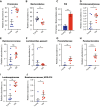Short-term dietary restriction in old mice rejuvenates the aging-induced structural imbalance of gut microbiota
- PMID: 31401701
- PMCID: PMC6790194
- DOI: 10.1007/s10522-019-09830-5
Short-term dietary restriction in old mice rejuvenates the aging-induced structural imbalance of gut microbiota
Erratum in
-
Correction to: Short-term dietary restriction in old mice rejuvenates the aging-induced structural imbalance of gut microbiota.Biogerontology. 2019 Dec;20(6):849-855. doi: 10.1007/s10522-019-09831-4. Biogerontology. 2019. PMID: 31501966 Free PMC article.
Abstract
The world's aging population is growing rapidly. Incidences of multiple pathologies, such as abdominal obesity, cardiovascular and cerebrovascular diseases, type 2 diabetes, and malignant neoplasms, increase sharply with age. Aged individuals possess a significantly shifted composition of gut microbiota, which is suggested to play important roles in aging associated pathologies. Whether the existing shifted structural composition of microbiota in aged populations can be reverted non-pharmacologically has not been studied so far. Here, we show an intestinal flora imbalance in old C57BL/6J mice with a remarkable dominant proportion of microbes promoting lipid metabolism and inflammation. Intriguingly, short-term (2 months) dietary restriction was enough to significantly revert the imbalance of intestinal flora in aged mice toward a more balanced structural composition as shown in young mice. Our study provides the first evidence that short-term dietary restriction in old mice can restore the already dysfunctional aged gut microbiota. Our study provides the first evidence that short-term dietary restriction in old mice can restore the already dysfunctional aged gut microbiota, which may help ameliorate aging-related disorders plaguing the vast elderly population.
Keywords: Aging; Dietary restriction; Gut microbiota; Inflammation; Obesity; Rejuvenate.
Conflict of interest statement
The authors declare that they have no conflict of interest.
Figures




References
-
- Amar J, Chabo C, Waget A, Klopp P, Vachoux C, Bermudez-Humaran LG, Smirnova N, et al. Intestinal mucosal adherence and translocation of commensal bacteria at the early onset of type 2 diabetes: molecular mechanisms and probiotic treatment. EMBO Mol Med. 2011;3:559–572. doi: 10.1002/emmm.201100159. - DOI - PMC - PubMed
-
- Bauer PV, Duca FA, Waise TMZ, Dranse HJ, Rasmussen BA, Puri A, Rasti M, et al. Lactobacillus gasseri in the upper small intestine impacts an ACSL3-dependent fatty acid-sensing pathway regulating whole-body glucose homeostasis. Cell Metab. 2018;27:572–587. doi: 10.1016/j.cmet.2018.01.013. - DOI - PubMed
Publication types
MeSH terms
LinkOut - more resources
Full Text Sources
Medical

